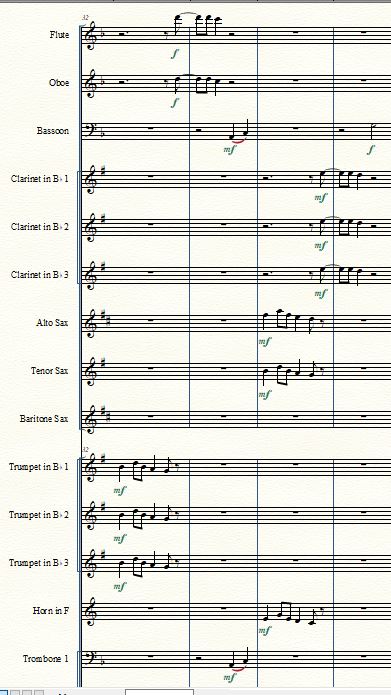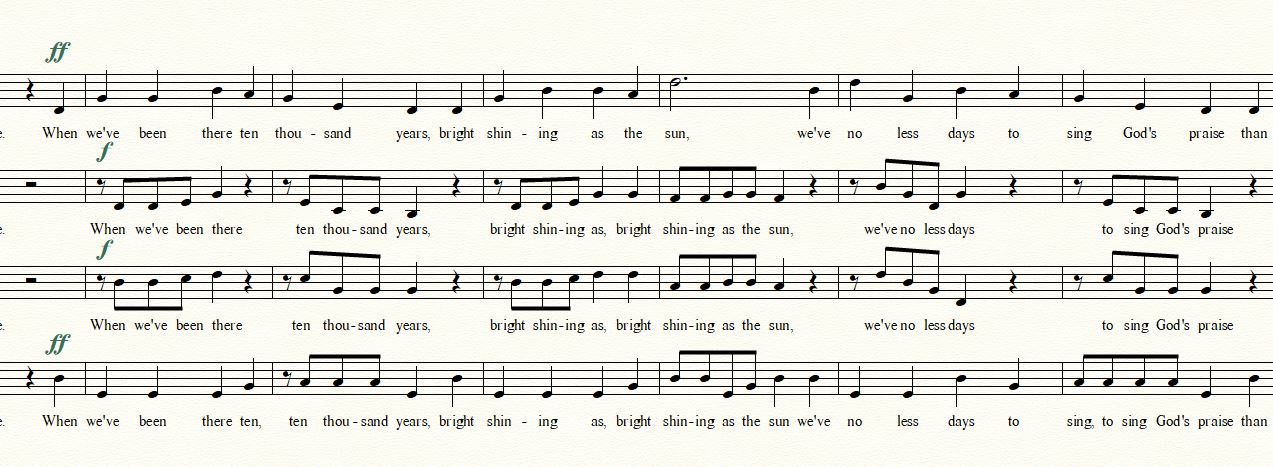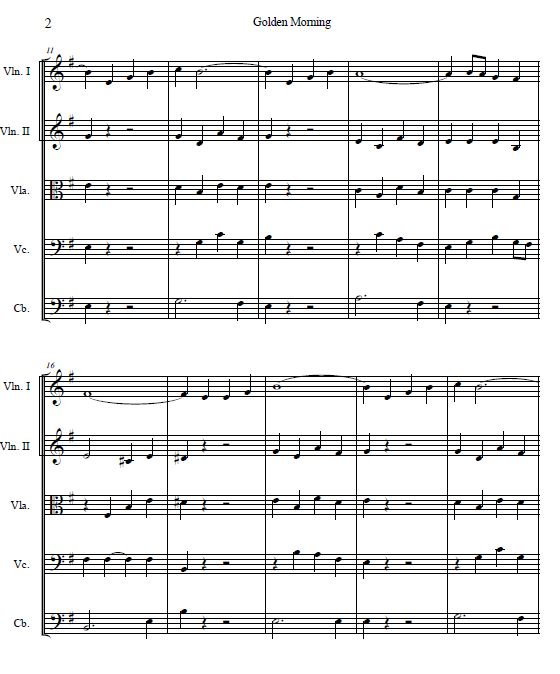Exploring Music Theory Through Concert Band, String Orchestra, and Choral Works

Understanding music theory can be an enriching experience, and one effective way to grasp its concepts is through the vibrant and diverse world of concert band, string orchestra, and choral works. These musical ensembles offer a unique lens through which we can explore fundamental music theory principles.
Very often, music theory is taught by teaching fundamentals and then analyzing simple music first, and then increasing the level of difficulty of the music that’s being analyzed, e.g., starting with simple piano music and moving on to analyze Bach pieces from The Well-Tempered Clavichord or something equally, difficult.
However, there is a wealth of music that has been produced by fine composers of music for concert band, string orchestra and choral groups that can offer a wealth of music to study. In this article, we will delve into how the elements of melody, harmony, rhythm, and form are exemplified in these settings, making the often complex world of music theory more accessible.
FOUNDATIONS: Music students should first understand the basics of music theory. These would include, but not be limited to:
Reading Music:
- Clefs (Treble, Bass and C (Viola)),
- Key signatures ( Major and Minor, and possibly a couple of more common modes, Aeolian and Mixolydian))
- Time signatures (2/4, 2/2, 3/4, 4/2, 5/4, 6/8)
- Note and rest values (including double whole note)
- Common tempo markings (Largo, Adagio, Andante, Moderato, Allegro and Vivace)
Familiarity with the Piano Keyboard – This is virtually imperative because it helps any music theorist visualize intervals, chord construction, scales and other parts of music. It’s not imperative that students know how to play piano well, if at all, although it would be useful if they knew basic hand positions and how to properly play chords. This skill would help them to be able to more accurately interpret some chord structures, runs and arpeggios, and musical interpretations in piano and organ music.
Ear Training – This includes:
- Being able to tell if an instrument is playing in tune with other instruments, or, as in the case of a piano or guitar, is in tune with itself.
- Being able to hear common intervals such as a major third, minor third, perfect fourth and fifth and octave.
- Being able to identify major and minor chords.
- Being able to determine if a piece of music is in a major or minor key, or in a mode and, possible, which one.
ELEMENTS: Now, here are some of the elements of Concert Band, Choral and String Orchestra music that can be used to fortify a student’s knowledge and use of music theory.
MELODY
These ensembles provide a rich canvas for studying melodies. Melody is a fundamental aspect of virtually any music. Except for drum lines and a few other rare exceptions, a musical work must have a melody. In these groups, melodies are often carried by different instruments or sections, allowing for a diverse and dynamic exploration of this concept.
For example, in a concert band, the clarinets might introduce a melody, passing it on to the flutes, and then to the brass section. This layered approach helps learners identify how a single melodic line can be interpreted and adapted by various instruments. Similarly, in choral works, different vocal sections may take turns carrying the melody, highlighting the versatility of melodic expression.
Personal note: When I was in high school, I arranged a few pieces for our concert band. My band director, Mr. Alfred Rosen, had made a few suggestions. One of which was to let different instruments play the melody. I knew what he meant and used that suggestion in a normal way in other pieces. At the time, I was working on “Windy” by The Association. Below is the section where I purposefully “over-did” his suggestion. (The bassoon is duplicated in the baritone and tuba.)

A collegiate music theory class may analyze a Bach fugue or a Schoenberg tone row piece, but the elements in those are difficult to interpret. The ensembles we’re using generally have a melody that is much easier to identify.
HARMONY
Harmony, and the formation of chords, is another essential part of music. Concert bands, string orchestras, and choral arrangements provide an excellent platform for studying harmony due to the variety of instruments and voices involved. Since this element is a bit more nuanced, here are some examples from each type of ensemble:
- In Choral Music – Choral works, with their intricate vocal harmonies, offer a unique opportunity to study how voices can complement each other to create a harmonious whole. In their simplest form, choral harmonies have four parts; the soprano most often has the melody, the alto and tenor parts fill in the chords and the bass part sings primarily the tonic of the chord. Below is a sample of such an arrangement by Salt Cellar called “Psalm 23 – Timeless”.

In more advanced works, the melody may be found in any part, the harmonies may or may not be complete since, sometimes, not all four parts are singing, and the chord may or may not be fully spelled out, utilizing only the most essential notes of that chord. In fact, in some pieces, chords may be hard to identify because of the intricate motion among the parts. Those, of course, would be left to the most advanced students to analyze.
Below is a sample of a somewhat complex arrangement, also by Salt Cellar. It’s not nearly as complex as music done for a more professional choral group because Salt Cellar writes for high school and community choral groups.

- In String Orchestra Music – String orchestras reveal the interplay among the instruments and showcase how harmony can be achieved through a blend of different timbres. Some chords are straight forward, but others can be a bit trickier to extract. Here is an original composition by Salt Cellar called “Golden Morning” that uses some variations on common chords to achieve some tension and release.

The structure of a string orchestra is very similar to a choral group and the parts are usually compatible with choral parts; the first violin plays what could be seen as the soprano part, the second violin plays alto, viola plays tenor part and double bass plays the bass part. Similarly, the parts can be switched to add color and flavor to a piece.
- In Concert Bands – Concert bands use brass, woodwind, and percussion instruments to build lush harmonic textures further enhances our understanding of this vital aspect of music theory. Concert band music has a lot more opportunity to contain chords with more than three or four notes, even though they would be repeated. However, great care must be take that this opportunity isn’t abused. A chord with more than four or five notes can sound messy; it’s more like a tone cluster. Of course, some contemporary composers are seeking that sound, and good composers know how to achieve it well.
In general, the harmony of a concert band also follows that of a choral arrangement, but it has many more available variations. The parts could be played by individual instrument parts such as oboe, first clarinet, alto sax and bassoon. Or, they could be played by groups of instruments like upper woodwinds, lower woodwinds, upper and lower brass. Of course, proper voicing techniques must be used to make any harmony sound great. The composer or arranger would have to make sure that lower voiced instruments didn’t play too close together, the parts given to upper woodwinds weren’t too high and close together and other such practices.
RHYTHM
Rhythm is a fundamental building block of music theory. Concert bands, string orchestras, and choral compositions provide a diverse range of rhythmic patterns, making them valuable for studying this concept.
In a concert band, the percussion section often takes center stage in illustrating rhythmic complexity. From the syncopated beats of a snare drum to the rhythmic precision of a bass drum, learners can discern the intricate layers that contribute to the overall rhythmic structure. In string orchestras, the rhythmic interplay between bows on strings can demonstrate how subtle changes in articulation can significantly impact the overall feel of a piece. Choral works, with their varied vocal rhythms, offer yet another avenue for exploring the rhythmic dimension of music theory.
The more interesting aspect of studying rhythm is understanding how overlaying rhythms can produce a whole new rhythm. A series of quarter notes being played against a series of quarter note triplets produces what sounds like a 6/8 pattern. Regularly spaced rests in two or more series of eighth notes can add the effect of accents without the musicians having to play any of the notes any louder.
FORM
Understanding musical form, the structure of a piece of music, is crucial for appreciating the organization and development of musical ideas. Concert bands, string orchestras, and choral compositions often adhere to traditional forms such as sonata-allegro, ternary, or rondo.
For instance, a concert band's performance of a symphony may follow a sonata-allegro form, with distinct sections for exposition, development, and recapitulation. String orchestras, in their interpretations of classical compositions, provide opportunities to identify recurring themes and structural elements. Choral works may exhibit ternary forms, with contrasting sections that contribute to the overall narrative of the piece.
* * * * * *
Where to Start – Desiring to use concert band, choral and string orchestra pieces for music theory study is great, but where should the study begin?
Choral works are the easiest, no matter how complex the piece itself may actually be. The reason is that choral works and the piano accompaniment are all in the same key. The only bit of transposing may be the tenor part which, if written in a octave clef (a Treble clef with a little 8 added below it), would need to be mentally transposed down an octave.
The next easiest would be string orchestra works. They are all in the same key as well, but, in addition to the treble and bass clefs, the alto clef would need to be learned since this is the clef in which the viola part is written.
The most difficult is the concert band. There are only two clefs, but as many as four or five different keys that would have to be transposed to concert key. That could be a lesson in itself. However, even without transposing the melody, harmony and rhythms could be extracted without too much difficulty.
In conclusion, using concert band, string orchestra, and choral works to study music theory offers a dynamic and engaging approach to learning. The diverse instrumentation, rich harmonies, intricate rhythms, and adherence to traditional forms provide a comprehensive foundation for grasping key concepts. By listening to and analyzing these musical ensembles, students and enthusiasts alike can deepen their understanding of music theory.
For the study of Music Theory, Salt Cellar Creations has a growing library of original works and arrangements that would make great study material. For recommendations, please Contact Us.
If you’re looking for new music for your ensemble, that growing library of works probably has something tat you’ve been looking for.
We have sold music not only in the US but in Canada, the United Kingdom, France, Australia, New Zealand and Austria. Please visit the WEBSITE or CONTACT US to find out what we can do for you!